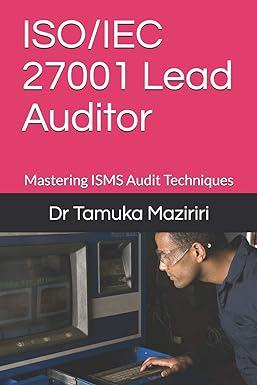Question
An airline is flying between two cities. The airline has the following costs associated with the flight: Crew $4000 Plane daily depreciation $2000 Fuel 1000
An airline is flying between two cities. The airline has the following costs associated with the flight:
Crew $4000 Plane daily depreciation $2000
Fuel 1000 Plane daily insurance 2000
Landing fee 1000
The airline has an average of 40 passengers paying an average of $200 for this flight. Do you think the airline should be flying between the two cities? Evaluate for a short-run and long-run perspective.
( Yes, No ), from a short-run perspective, the airline ( should, should not ) make this flight between the two cities. The total variable costs are $________ (= $______ + $_______ + $_______). The total revenue is $_______ (= $____ ____ ). Thus the flight covers total variable cost and leaves $2000 to apply against $4000 of total fixed cost. If the plane did not fly, the firm would lose the entire $4000 of total fixed cost.
The average variable costs are $_____ per passenger (=$____ ____ passengers). The price, or average revenue of $______ , is greater than the average variable cost of $______. The airline received enough revenue to cover average variable costs and also $50 per passenger to offset fixed costs that average $100 (=AFC = TFCQ =$400040).
( Yes, No ), from a long-run perspective. The price of $200 is ( greater than, equal to, less than ) ATC of $_____ (=ATC= TCQ =$_______ ____ ). The airline is (gaining, losing) $___ per passenger, or $2000 per flight, and ( can, cannot ) afford to take this ( gain, loss ) on each flight in the long run.
What is the major difference between the long run and the short run in pure competition? Explain in terms of the number of firms and the flexibility of firms.
In the short run there is ( no, some, many ) entry or exit of firms in pure competition. The number of firms and plant size is ( fixed, varied ). Firms can either produce or shut down. If they shut down, they do not have time to liquidate their assets or go out of business. In the long run there ( can, cannot ) be entry and exit of firms into an industry. Firms that shut down in the short run because they are experiencing economic losses will eventually liquidate assets and go out of business if the losses persist over time. Existing firms in the long run can expand or contract their capacity to produce. In the long run, new firms can enter an industry and increase the industry output.
Is there a specific amount of time that distinguishes the long run from the short run? Is the amount of time important?
( Yes, No ). The amount of time will vary by industry. The difference could be months or years. The key point is that in the short run things (number of firms and size of firms) are ( fixed, variable ), but as incentive changes, then in the long run things (number of firms and size of firms) ( remain constant, change ). What is more important than the specific amount of time is the process of profit and loss incentives that direct resources either to an industry or away from an industry.
What three assumptions are used in the chapter to keep the analysis relatively simple?
The three assumptions are:
(a) __________________________________________
(b) ____________________________________________________
(c)_____________________________________________________
How do the entry and exit of firms in a purely competitive industry affect resource flows and long?run profits and losses?
Entry and exit help to improve resource (a___________.)
Firms that exit an industry due to low profits release their resources to be used more profitably in other industries. Firms that enter an industry chasing higher profits bring with them resources that were less profitably used in other industries. Both processes increase (a ____________ efficiency).
In the long run, the market price of a product will equal the ( m_____ a_______ t_____ cost ) of production. Thus, long run economic profits are ( zero, positive, negative ).
Why will the long-run product price for a perfectly competitive firm equal its minimum ATC?
Firms will seek (profits, losses ) and shun (profits, losses ), and firms are free to enter and exit (under pure competition case).
If the market price initially exceeds minimum ATC, the resulting profits will attract new firms to the industry, leading to a(n) ( increased, decreased ) supply in the industry thus bringing back down the market price to the minimum ATC.
Conversely, if the price is initially less than the minimum ATC, resulting losses will drive out firms, leading to a(n) ( increase, decrease ) in supply, thus bringing the price back up to the minimum ATC.
Step by Step Solution
There are 3 Steps involved in it
Step: 1

Get Instant Access to Expert-Tailored Solutions
See step-by-step solutions with expert insights and AI powered tools for academic success
Step: 2

Step: 3

Ace Your Homework with AI
Get the answers you need in no time with our AI-driven, step-by-step assistance
Get Started


